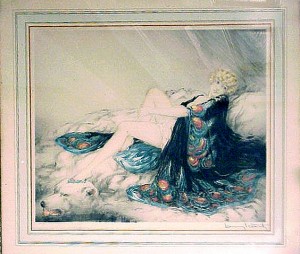Icart was most popular in the 1920s and ’30s. At the time, it was fashionable to give a gift for a wedding or special occasion, rather than money. What better gift than an Icart etching? They were beautiful, signed by the artist, limited edition, and reasonably priced, most in the range of $15-30. The sellers of the art, mainly art galleries and department stores, were not interested in the art as investment, so they were expedient in framing.

Icart "Silk Robe" in original frame. The mat is glued to the etching and the etching is glued to a board.
The second problem is acidity. Paper is naturally acidic due to the acid in pulp, mainly tannic acid. Over time cellulose fibers in the paper break down and add to the acidity. The framer’s offense was to use acidic mats and back boards in framing the etchings. These materials were in constant contact with the etching, allowing acid to leach onto the paper. All of these acid sources contribute to the problem. The acidity causes the paper to weaken and degrade, making it brittle and yellow and eventually destroying it.

After the mat has been removed, the moderate light darkening of the image is evident

An Icart etching with foxing in the margins
Can anything be done about these problems? Tune in tomorrow for “My Icart etching doesn’t look good. What can I do about it?”
Please send me your suggestions or questions about art glass, lamps, Louis Icart, shows, auctions, etc. If it’s interesting, I’ll answer your question in a future blog entry.
Call or write and let me know what you would like to buy, sell, or trade. philchasen@gmail or 516-922-2090. And please visit my website. chasenantiques.com
